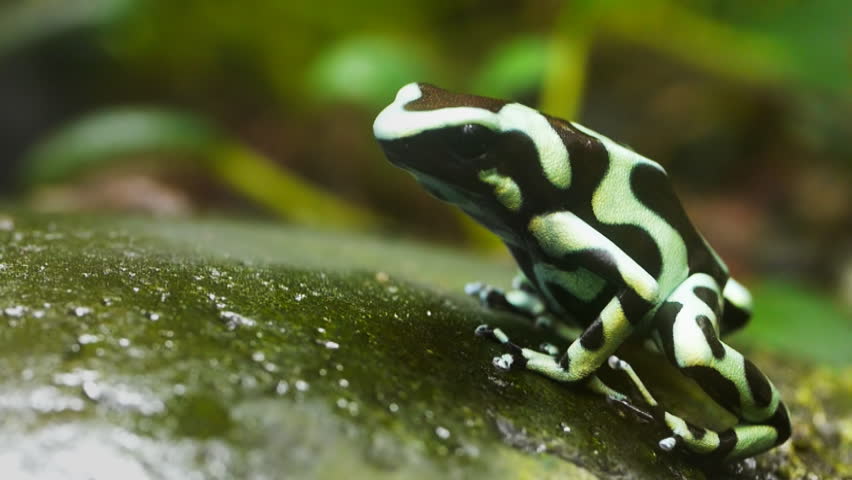ANIMAL: Green and Black Poison Dart Frog Dendrobates auratus Type of Animal: Frog Habitat: Wet forest, humid lowlands, plantations, humid leaf litter, humid areas near streams/creeks, small pools, small streams, puddles Location(s): Ranges from SE Nicaragua to small area of NW Colombia near Panama. Introduced to Hawaii. Appearance: Green interspersed w/ black, females larger than males, fairly small frog (medium-sized for poison dart frogs), some variation in color Food/Diet: Fruit flies, crickets, mosquitoes, ants, termites, beetles, mites, spiders, tadpoles/froglets of own species. Tadpoles also eat rotifers, protozoans, algae, & woody detritus. Status in Wild: Stable Conservation: Breeding in zoos, aquariums, & herpetoculture Lifestyle: Groups of 2-8 frogs Additional Info: Called: Male Female Young: Tadpole Group: Army Weight: Male: 0.1 oz Female: 0.2 oz Gestation: 2 weeks Life Span: 5-6 years in wild, 10 years in captivity Body Length: Male: 0.75 in Female: 1 in Due to skin toxins, only predators are some snakes. Tadpoles/froglets prey on each other. Active during the day (diurnal). Females lay around 6 eggs per clutch in pool of water. When eggs hatch, male attaches tadpoles to back & carries to them to water body where they’ll stay for 1.5-3 months until they reach froglet stage, which they stay in until around 7-10 months old. Introduced in Hawaii in 1932 to control insect populations but are an invasive species due to lack of predators. While still toxic, these frogs not nearly as toxic as frogs in native range due to food there not being as poisonous as food in native range. Males make trilling sounds to attract females. Capture prey using sticky retractable tongue. Also called Green & Black Poison Frog, Green & Black Poison Arrow Frog, & Green Poison Frog. Small sucker-like disks at toe ends aid in climbing. Fun Fact(s): Coloration serves as warning to potential predators. While highly poisonous in wild, they lose much/all of toxicity in captivity due to diet. In captivity, they’re only fed nontoxic prey items like crickets & fruit flies. In wild, they eat lots of ants, termites, & poisonous beetles. Used in medical research due to skin toxins being possible medicine source. Pharmaceutical companies investigating possibility of painkiller ABT-594 being developed from compound called Epibatidine found in this species. In parts of Hawaii, they’ve been seen depositing eggs in broken beer bottles & old cans. Hunters use skin toxins on darts & arrows.
